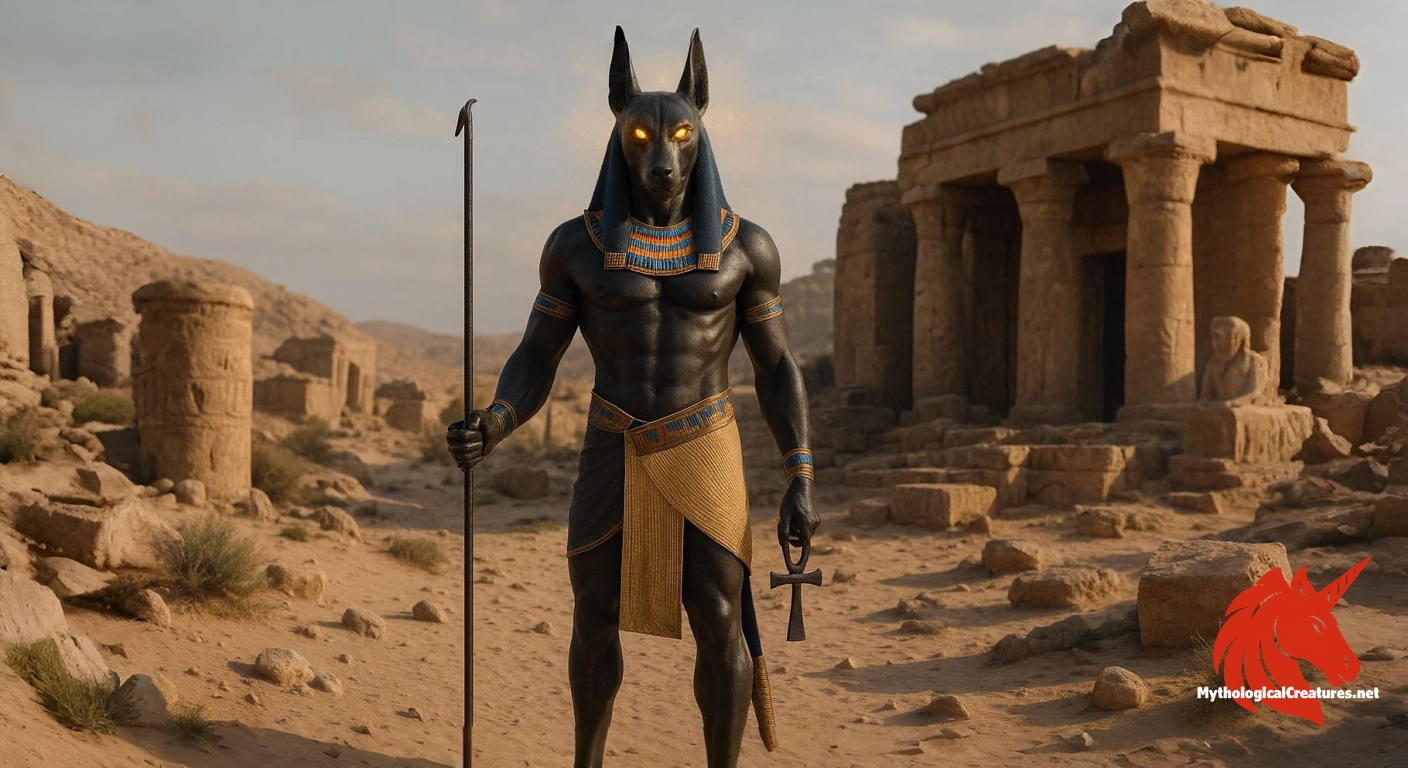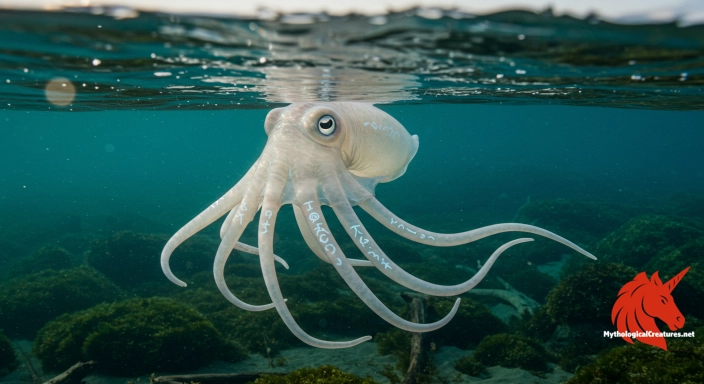Anubis: Anubis is the ancient Egyptian god of funerary rites, typically depicted with a canine head or as a jackal.

Anubis
Anubis - Central to Egyptian funerary practices and afterlife beliefs
Origins & First Encounters
Anubis is a central figure in the rich tapestry of ancient Egyptian mythology, embodying the mystery of life’s transition into death. His origins can be traced back to the early dynastic period where he emerged as a guardian of graves and a facilitator of funerary rites. His role was established in the First Dynasty, a time when the cult of the dead played an essential part in Egyptian society. The deity is known by several names, including Inpu and Anpu, which reflect the diversity of ancient Egyptian language and culture. He is most famously depicted as a man with the head of a canine, a choice that symbolises both the wild yet loyal nature of the animal and the untamed aspects of the afterlife. This divine figure was responsible for guiding souls and safeguarding the sanctity of tombs against desecration. His image was a staple in temple reliefs and funeral texts, underscoring his seminal role in the spiritual practices of his time. The cultural context in which he thrived was one where death was seen as a passage to a new form of existence, making him integral to the belief in rebirth. His enduring presence in ancient iconography highlights not only his protective power but also the profound Egyptian reverence for the mysteries of death.
Source Texts & Tale Variants
Ancient inscriptions and funerary texts provide a vivid account of Anubis’s role, revealing his significance in rituals and the afterlife. His image appears in some of the earliest hieroglyphic records, including temple reliefs and tomb inscriptions that have been studied for centuries. Various papyri and stone stelae contribute to our understanding of his function during the Weighing of the Heart ceremony, where he assisted in determining the fate of the soul. Literary fragments from the Pyramid Texts, Coffin Texts, and other sacred manuscripts detail his responsibilities and his connection with the process of embalming. In addition, later Greek sources reference Anubis, offering a perspective on how his sacred functions resonated beyond the borders of Egypt. The diversity of primary sources, from monumental carvings to delicate papyrus scrolls, illustrates the multi-faceted nature of his worship. Over time, different versions of his myth arose, weaving together local traditions with pan-Egyptian influences. The surviving texts, though sometimes fragmentary, allow us to piece together the evolution of his character as both a protector of the dead and a guide into the realm of the afterlife.
Form & Powers
Anubis is predominantly portrayed with a distinctive canine head, commonly identified with a jackal, seamlessly integrated onto a human body. His visage is characterised by alert, pointed ears and keen eyes that seem to unfailingly watch over the passage of souls. The frequent use of black colouring in his depictions symbolises regeneration, the vitality of the Nile’s soil, and the transformation associated with embalming. Ancient artists captured his form with a blend of human dignity and animalistic attributes, ensuring that each detail – from the texture of his fur to the serene expression of his face – conveyed a sense of vigilant protectiveness. His anthropomorphic body is often shown in a relaxed yet authoritative stance, reflecting the duality of his role as both a guide and a guardian. Some representations highlight subtle variations, with different regions accentuating varying levels of realism and abstraction in his features. The emphasis on his canine characteristics underlines a deeper spiritual symbolism, linking him with both the wild and the controlled aspects of life. This synthesis of human and animal forms not only cements his status as a divine figure but also encapsulates the deep interplay between nature and the supernatural in ancient symbolism.
Regional Faces
The depiction of Anubis varied notably across different areas of ancient Egypt, each region adapting his iconography to local spiritual needs and artistic traditions. In Upper Egypt, he was often showcased with a strong emphasis on his role as a protector and guide, his imagery crafted to evoke a sense of solemn guardianship over the deceased. Down in Lower Egypt, his portrayals sometimes merged his character with other local dog-headed deities, resulting in a fusion of myths and functions. Such local adaptations underscored the dynamic and utilitarian nature of myth in contemporary religious practices. Different communities thus embraced his image, tweaking details such as his posture and adornment to align with regional artistic conventions. The evolution of his iconography in various locales vividly reflects the adaptability of religious symbols across time and space. Local myths occasionally interwove his story with other deities, highlighting unique aspects of the underworld that resonated with the local populace. These regional variations not only enriched his mythos but also contributed to the broader, more complex narrative of ancient Egyptian spirituality.
Cultural Parallels
Anubis occupies a unique position on the global mythological stage, where his role as a guide and protector of the dead finds echoes in the deities of other cultures. His function as a psychopomp is reminiscent of figures like Hermes in Greek mythology, who similarly transported souls to the afterlife. The integration of animal features with human traits, as seen in Anubis, is a motif present in various mythologies where the animal world symbolically connects with the spiritual. In certain traditions, creatures such as the three-headed Cerberus guard the thresholds of the underworld, yet Anubis’s approach is marked by a profound sense of responsibility and care. The blending of human intelligence with instinctive animal loyalty in his imagery parallels other guardians associated with death in a number of cultures. His role as an embalmer and facilitator of rebirth also correlates with elements of other ancient rituals that link death with the possibility of renewal. This cross-cultural phenomenon reflects a universal human desire to understand and ritualise the transition from life to death. Anubis’s mythology, while distinctively Egyptian, thus resonates with a broader narrative of spiritual guidance that transcends geographical confines.
Legacy & Modern Evolution
The historical evolution of Anubis illustrates a remarkable journey from a revered ancient deity to a figure that continues to captivate modern imagination. Over the centuries, his image has transformed from early tomb carvings and temple designs into a symbol of the eternal cycle of life, death and rebirth. As the religious landscape of Egypt evolved, so too did his myth, gradually absorbing and adapting to new theological frameworks while never losing his core identity. In more recent times, his iconic canine head and mysterious aura have influenced literature, film, and visual arts, ensuring that his legacy endures beyond the confines of traditional religious practice. Modern reinterpretations often blend his ancient symbolism with contemporary themes of mystery and transformation, appealing to a wide audience fascinated by mythology. His continual appearance in popular culture, from graphic novels to video games, speaks to his enduring power as a symbol of the unknown territories beyond mortal life. Artists and scholars alike have reimagined his role, highlighting the timeless appeal of themes related to mortality and the afterlife. In this way, Anubis remains both a historical figure and a contemporary emblem of spiritual exploration.
Interesting Fact
Anubis' iconic representation has influenced not only ancient Egyptian funerary practices but also modern portrayals of the afterlife, making him one of the most recognisable deities in world mythology.
Quick Creature Info
Origin:
Features:
Associations:
Our Mythic Legendary Rating:

Also Sometimes Known As:
Habitat:
Supernatural Powers:
Physical Attributes:
Abilities:
Behavior:
Lore:
References
Discover Another Mythical Legend You May Not Have Heard Of?
Uncover the mysteries of ancient folklore and expand your knowledge of legendary beings from cultures around the world.
Dare to Meet the Koromodako....
Mythical Disclaimer: The images and data on this site are derived from various historical and literary sources, but we have found that many myths often have multiple versions and interpretations across references, sometimes contradictory. As a result, these creature depictions are artistic interpretations—imaginative blends of folklore, legend, and a dash of AI guesswork. Because creature descriptions vary widely, our illustrations and accompanying information represent our best effort to honor mythology while bridging creative gaps. Enjoy these interpretations—just remember, we've done our best to respect the stories and validate available data, but in the realm of mythology, details often shift, imagination leads the way, and nothing is ever set in stone!
Curated by the Mythological Creatures Team (rev. May 2025)
